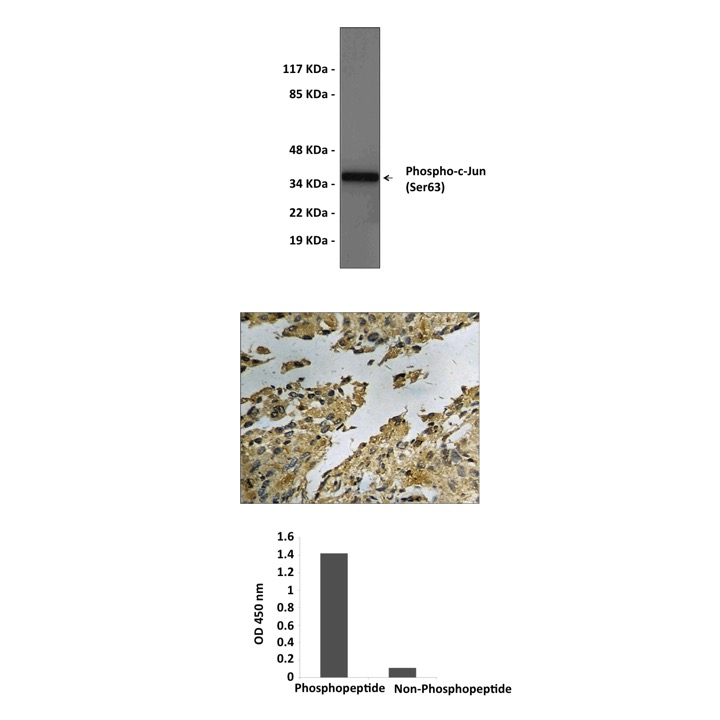Product Sheet CG1088
Description
BACKGROUND c-Jun belongs to the AP-1 family of proteins whose members can form heterodimeric transcription complexes and are characterized structurally by the basic region-leucine zipper motif. c-Jun regulates gene expression and cell function by participating in the formation of a variety of dimeric complexes that display high affinity sequence-specific DNA-binding activity. These include both Jun–Jun and Jun–Fos dimers, which recognize AP-1 sites (-TGAGTCA-), as well as Jun–ATF dimers, which bind cyclic AMP responsive element (CRE)-like sites (-TGAGCTCA-).1
Both c-Jun and its dimerization partners are subject to regulation by an incredibly diverse array of extracellular stimuli. Mitogens or various forms of stress regulate either the transcriptional activity of c-Jun directly, or the abundance of the protein by modulation of its stability.2 The transcriptional activity of the c-Jun protein is regulated by its phosphorylation status. Phosphorylation of c-Jun at Thr-231, Ser-243, and Ser-249, near its DNA-binding domain, inhibits DNA binding and therefore reduces transcriptional activity.3 Phosphorylation of two of Thr-231 and Ser-249 is catalyzed in vivo and in vitro by casein kinase II. Ser-243 is the major site of phosphorylation by ERG. These inhibitory phosphate groups are lost after phorbol ester (TPA) or serum stimulation. On the other hand, phosphorylation of serine 63 and serine 73 (human amino acid sequence) increases in response to growth factor or UV signaling and enhances the transcriptional activity of c-Jun. This inducible phosphorylation event is controlled by a well-defined signaling pathways culminating in the activation of MAP-type kinases (MAPK). These kinases include ERK, JNK or SAPK, all of which potentially use c-Jun as a substrate, albeit with varying efficacy.4
Both c-Jun and its dimerization partners are subject to regulation by an incredibly diverse array of extracellular stimuli. Mitogens or various forms of stress regulate either the transcriptional activity of c-Jun directly, or the abundance of the protein by modulation of its stability.2 The transcriptional activity of the c-Jun protein is regulated by its phosphorylation status. Phosphorylation of c-Jun at Thr-231, Ser-243, and Ser-249, near its DNA-binding domain, inhibits DNA binding and therefore reduces transcriptional activity.3 Phosphorylation of two of Thr-231 and Ser-249 is catalyzed in vivo and in vitro by casein kinase II. Ser-243 is the major site of phosphorylation by ERG. These inhibitory phosphate groups are lost after phorbol ester (TPA) or serum stimulation. On the other hand, phosphorylation of serine 63 and serine 73 (human amino acid sequence) increases in response to growth factor or UV signaling and enhances the transcriptional activity of c-Jun. This inducible phosphorylation event is controlled by a well-defined signaling pathways culminating in the activation of MAP-type kinases (MAPK). These kinases include ERK, JNK or SAPK, all of which potentially use c-Jun as a substrate, albeit with varying efficacy.4
REFERENCES
1. Herdegen T et al.: Trends in Neurosci. 20:227-231, 1997.
2. Rahmsdorf HJ: J. Mol. Med. 74: 725–747, 1997.
3. Lin A et al.: Cell 70:777-89, 1992.
4. Smeal T et al.: Mol. Cell. Biol. 12:3507-3513, 1992.
2. Rahmsdorf HJ: J. Mol. Med. 74: 725–747, 1997.
3. Lin A et al.: Cell 70:777-89, 1992.
4. Smeal T et al.: Mol. Cell. Biol. 12:3507-3513, 1992.
Products are for research use only. They are not intended for human, animal, or diagnostic applications.
Details
Cat.No.: | CG1088 |
Antigen: | Range AA51 to 80 |
Isotype: | Rabbit IgG |
Species & predicted species cross- reactivity ( ): | Human, Mouse, Rat |
Applications & Suggested starting dilutions:* | WB 1:500-1:1000 IP n/d IHC 1:50-1:100 ICC n/d FACS n/d |
Predicted Molecular Weight of protein: | 35 KDa |
Specificity/Sensitivity: | Detects endogenous c-Jun proteins without cross-reactivity with other family members. |
Storage: | Store at -20°C, 4°C for frequent use. Avoid repeated freeze-thaw cycles. |
*Optimal working dilutions must be determined by end user.
Products
| Product | Size | CAT.# | Price | Quantity |
|---|---|---|---|---|
| Rabbit c-Jun, Phospho-Ser63 Antibody: Rabbit c-Jun, Phospho-Ser63 Antibody | Size: 100 ul | CAT.#: CG1088 | Price: $384.00 |

